Tower Farming for refugee camps and/or developing communities
Tower farming, also known as vertical farming, is a sustainable practice with immense potential for refugee camps and developing communities. It involves growing crops in stacked layers indoors, making it resource-efficient and ideal for areas with limited arable land. Vertical farming ensures year-round fresh produce, conserves water, and provides a controlled environment, reducing crop risks. It offers crop diversity, fits into small spaces, fosters skill development, and enhances community resilience by reducing food dependency. Moreover, it’s environmentally friendly and can be tailored to different community needs. Let’s get into the countries where Vertical Farming has been implemented and their impacts! ‘
Vertical farming is gaining momentum and being explored for implementation in various developing countries as a means to address food security, limited agricultural space, and sustainability concerns; some of these countries included India, Kenya, Nigeria, South Africa, China (particularly in regions with limited arable land), and Brazil, where initiatives were emerging to boost urban food production.
Africa
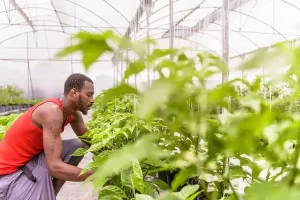
As of December 2022, five aeroponic Tower Farms have been established in Africa, including two in Kenya, one in Equatorial Guinea, one in Nigeria, and one in Cape Verde. These projects have underscored the importance of vertical farming technology in the African context. Vertical farming offers significant water savings of up to 95% compared to traditional agriculture and the ability to grow food in urban areas. What sets this technology apart is its accessibility; it requires no prior agricultural experience or a “green thumb.” Unlike traditional hydroponic commercial farms, Tower Farms do not necessitate the presence of agronomists or horticulturists, making it accessible to anyone with motivation. Tower Farm projects are planned to expand across numerous African countries, including Algeria, Cape Verde, Central African Republic, Congo, Djibouti, Egypt, Guinea, Ethiopia, Gambia, Gabon, and Ghana, just to name a few. Tower Farms utilizing Tower Garden aeroponic technology offer a self-sufficient agricultural solution for Africa.
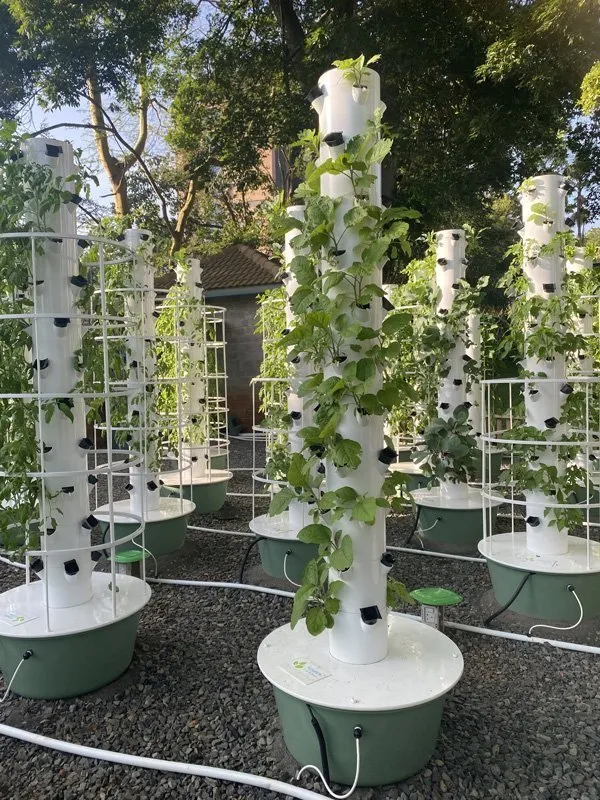
India
Ponic Greens Advance Hydroponic Technology has made significant strides in India’s agricultural sector. Their innovative hydroponic technology has revolutionized the way crops are grown and has addressed various challenges faced by traditional farming methods in the country.
One of the key achievements of Ponic Greens is the promotion of soilless farming through hydroponics. This method allows for the cultivation of a wide variety of crops in a controlled environment, using nutrient-rich water solutions instead of soil. This approach has several advantages, including increased crop yields, reduced water usage, and the ability to grow crops in areas with poor soil quality.
Ponic Greens has also played a crucial role in promoting sustainable agriculture practices in India. By minimizing the need for pesticides and herbicides, hydroponic farming reduces the environmental impact of agriculture and promotes healthier and safer food production. Additionally, the controlled environment of hydroponic systems helps protect crops from adverse weather conditions and pests.
Furthermore, Ponic Greens has been actively involved in training and educating farmers about hydroponic farming techniques. Their efforts have empowered many farmers across India to adopt this modern and sustainable approach to agriculture, leading to improved livelihoods and economic benefits.
In summary, Ponic Greens Advance Hydroponic Technology has made a significant impact in India by introducing and promoting hydroponic farming methods. Their efforts have contributed to increased agricultural productivity, environmental sustainability, and the empowerment of farmers through education and technology adoption.
Jordan
In a region where most of the land is desert, there are growing challenges with not having enough water and being able to grow crops. Jordan is making big efforts to use smart water technologies to deal with these problems. At the same time, UNHCR is actively looking into the idea of hydroponics in the Zaatari refugee camp.
Hydroponics is a different way of farming that doesn’t need soil. Instead, plants are grown in a water-based system with nutrients added to the water.
So far, more than 600 people in Zaatari have learned about hydroponics. This project is not just helping refugees in the camp; it’s also raising awareness in Jordan, a country that has very little water and is one of the driest in the world. Omar Alrababah, who is part of the hydroponics project funded by the University of Sheffield, emphasized this.
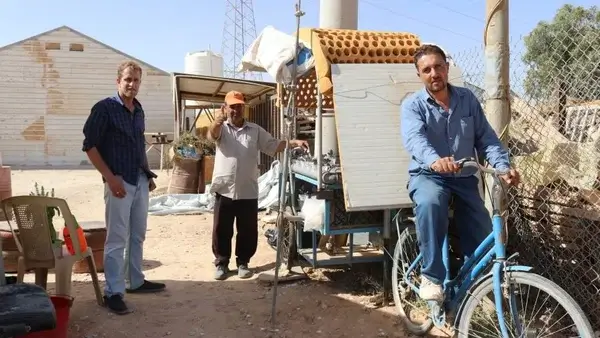
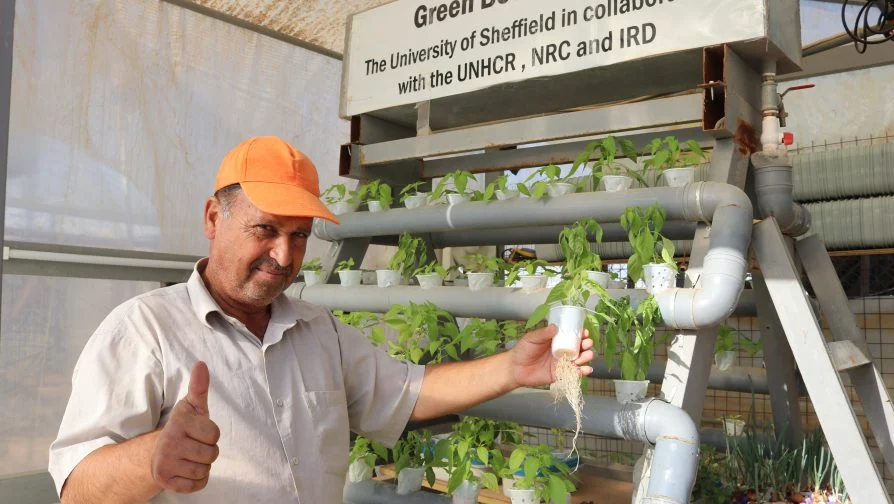
The project started in December 2017 with a hydroponic prototype and officially launched in November the next year. It has since grown with two more prototype hydroponic systems and many training sessions for camp residents. UNHCR, working with the University of Sheffield, Blumont, and the Norwegian Refugee Council, has successfully trained over 1,000 camp residents in this innovative way of farming.
Hydroponic Blueberries in Peru
Winners Capital Peru, new to hydroponic blueberry farming, partnered with Galuku to help them reach their objectives. In a market known for its intense competition in blueberry production, the assistance from Galuku and the excellence of our products played a crucial role in Winners Capital Peru’s success in producing high-quality, competitive blueberries.
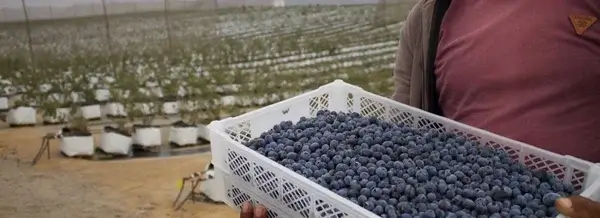
Peru is known as a top global supplier of fresh blueberries, thanks to its extended growing seasons and ample arable land. The country’s position in the global blueberry market is expected to remain strong, with blueberries being Peru’s second most crucial agricultural export. Recognizing the significance of leadership in this market, Winners Capital Peru sought assistance from Galuku to venture into hydroponic blueberry cultivation.
Challenges: Prior to their current blueberry crop, Winners Capital had no prior experience in commercial farming. To acquire the necessary knowledge and skills, their growers engaged in extensive online training sessions with Galuku’s technical team. These sessions have played a pivotal role in the success of Winners Capital’s blueberry cultivation.
As newcomers to the industry, they not only had to grasp the intricacies of a new field and its technical aspects but also had to navigate the complex import procedures in Peru. However, the strong rapport between the owner of Winners Capital and Galuku’s International Business Development Manager, Philip Martyn, facilitated open communication and enabled them to overcome all challenges successfully.
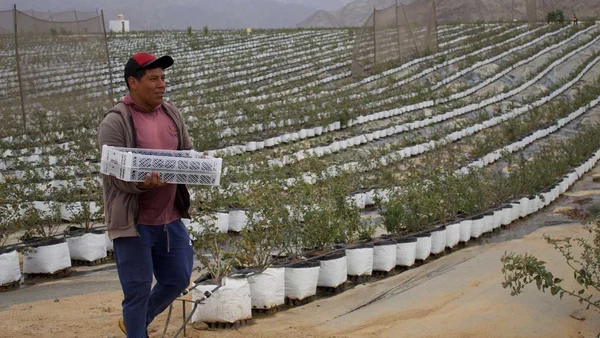
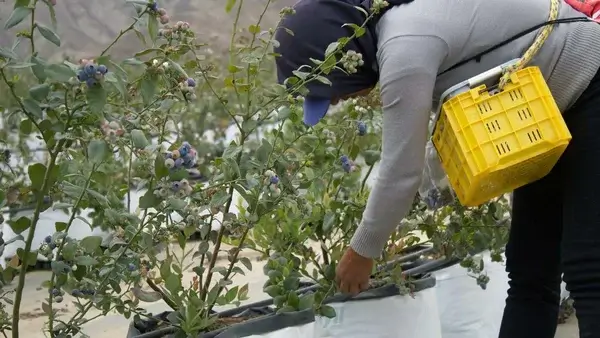
The Solution: The owner of Winners Capital explained, “After researching various options, we opted for the Galuku Coco Coir System primarily to ensure optimal plant growth.” To achieve the best possible results for our blueberry crop, collaborating with Galuku and utilizing their coir and planter bags was the clear and logical choice.
The owner further stated, “The Galuku Coco Coir Easyfil system streamlines the installation of grow bags for our blueberries, saving us time, effort, and costs. Additionally, we’ve observed that Galuku’s Coco Coir promotes robust root development in our plants while effectively retaining water and nutrients. Their products also provide excellent drainage to prevent sodium buildup.”
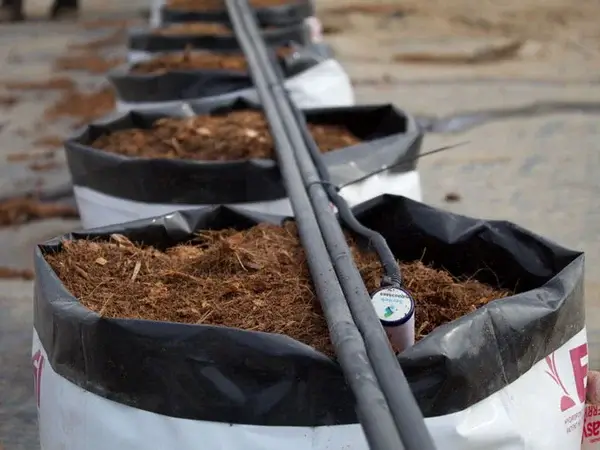
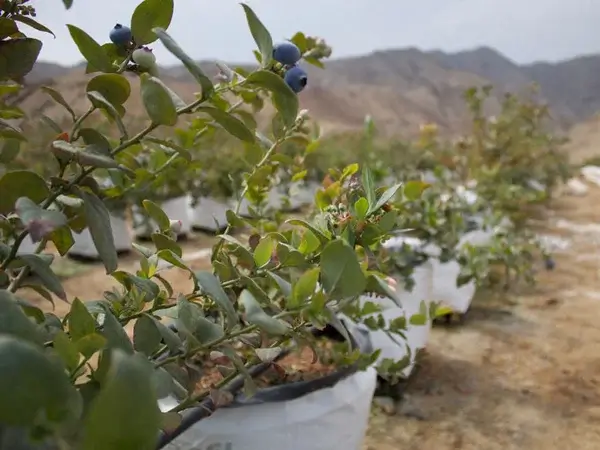
The Outcomes: Upon the implementation of Galuku’s specialized coir substrate along with our Easyfil PlanterBag system, Winners Capital Peru witnessed remarkable growth and quality improvement in their blueberry crop. According to the owner of Winners Capital, Galuku’s products played a vital role in helping their blueberries meet their targets in terms of Brix, Caliber, and Firmness. Furthermore, they found Galuku’s coco coir to be of exceptional quality and noted that once hydrated, it exhibited all the necessary characteristics to help them achieve their goals.
The owner also emphasized the significant impact of Galuku’s support, stating, “Galuku’s support has always been immediate, and they consistently exceeded our expectations.”
Vertical Farming for Refugees
For refugees and internally displaced people (IDPs) worldwide, gardening is not just a pastime; it’s a way to survive.
Currently, we face the largest refugee crisis ever recorded, with over 26 million people living far from home in host communities, as reported by the United Nations High Commissioner for Refugees (UNHCR). For many IDPs and refugees, arriving at a camp is just the beginning of a challenging journey. They must try to rebuild their lives in cramped, often harsh environments with inadequate sanitation, low-quality food, and limited opportunities to earn a living.
Our work with refugees and IDPs covers various areas like water, sanitation, hygiene, shelter, and hunger and nutrition. Vegetable gardens are one of the ways we fight malnutrition in refugee camps. These gardens enable people to add variety to their diets and enhance the quality of their food. They also bring about social benefits, including empowering women and creating income opportunities.
Nonetheless, given the challenging terrains, restricted areas, lack of fertilizers, and limited water resources, a variety of creative methods and resourceful gardening skills play a significant role in the success of these vital vegetable gardens. Here are a few of these innovative techniques.
Slope Gardening
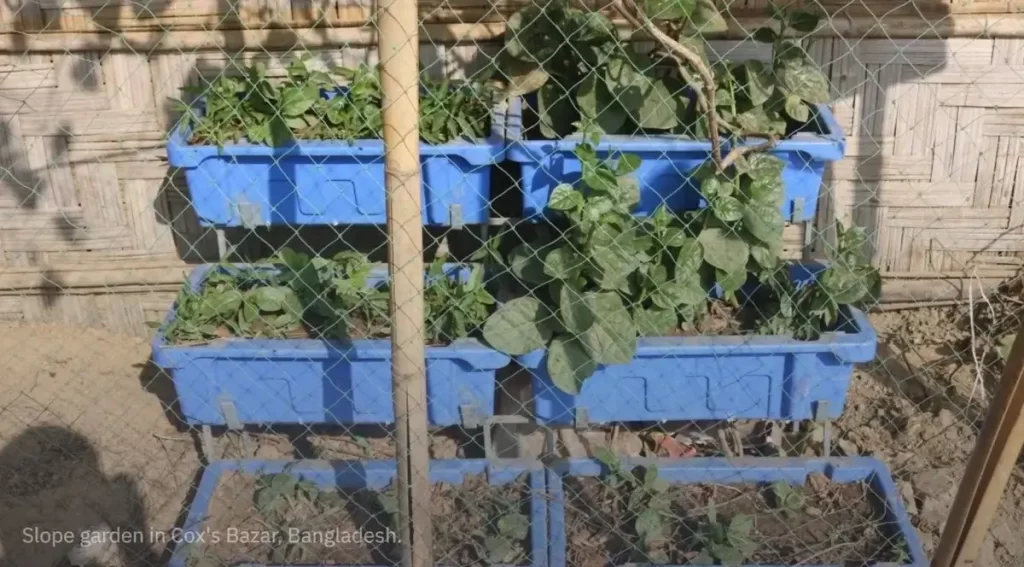
Slope gardening is an effective method for optimizing space, and it’s as straightforward as it sounds! This technique involves planting crops on a hill. Creeper plants like cucumbers and vegetables with branching root systems, such as okra and eggplants, work well for slope gardening.
The key is to plant and nurture these crops in small pits while implementing measures to prevent soil erosion and minimize water loss due to evaporation.
Multilayer Gardening
Multilayer gardening is a valuable technique, especially when dealing with limited space, a common challenge in crowded refugee camps. Essentially, it involves cultivating compatible plants of varying heights simultaneously in the same area. The term “compatible” is used because certain vegetables shouldn’t be grown together.
Conversely, some plants thrive when grown alongside one another and complement each other. For instance, corn, beans, and squash work harmoniously. The corn provides support for the climbing beans, while the squash covers the ground, offering moisture protection. Some plants can also climb independently, provided they have suitable supports to twine around.
In the world’s largest refugee camp, Cox’s Bazaar in Bangladesh, we encourage people to utilize multilayer gardening for cultivating leafy vegetables and fruits.
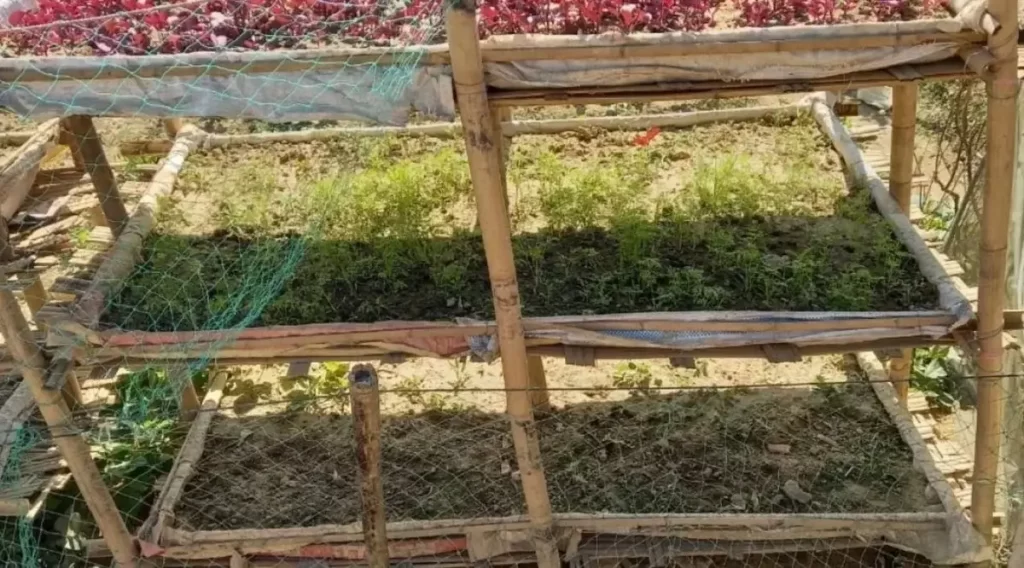
Vertical Gardening
Once again, vertical gardening is quite straightforward – it involves growing vegetables in a vertical direction, making the most of limited space while allowing for more nutritious crops. To create a vertical garden, you’ll need to set up a vertical structure, like a tree or a fence, for plants to climb on, thereby creating room for other vegetables to grow beneath them.
The sack and pit method is another space-efficient technique often used in vertical gardens. It requires even less space, conserves water efficiently, prevents soil erosion, and is easily portable. In the Rohingya Refugee camp, we collaborate with individuals to cultivate sweet gourd, a type of long vegetable that’s a running or climbing vine. A trellis is essential for the vegetable to climb on.
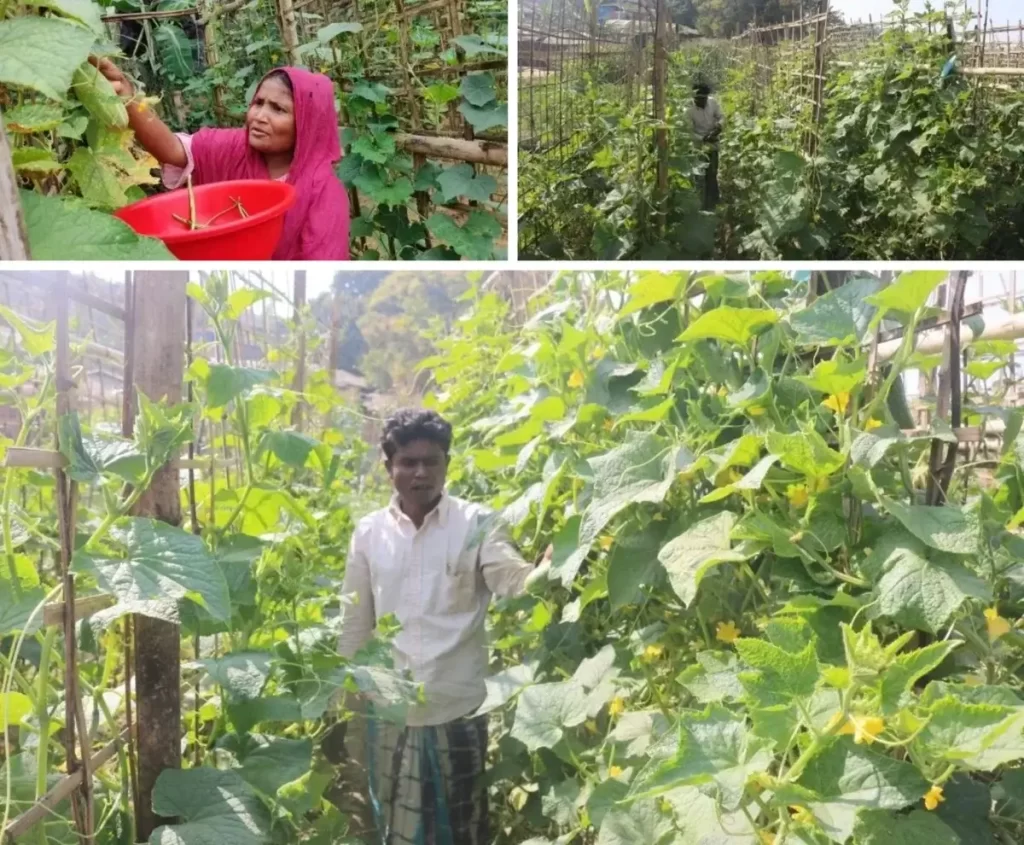
Communities participating in Concern’s gardening initiatives, like these, can enhance their vegetable consumption and, in some instances, generate income when provided with the appropriate tools and guidance.
Upon their arrival at refugee camps, displaced individuals often face unfamiliar surroundings and the challenge of securing land and alternative food sources. The distribution of seeds and fertilizer for vegetable gardens encourages a shift toward collective thinking about space and fosters a sense of community. In Cox’s Bazar, many refugees now collaborate by sharing their seeds and crops. With the assistance of Concern’s technical support, they are also learning about vertical gardening to produce substantial quantities of vegetables in limited areas.
The Green Refugee Camp
The Green Refugee Camp successfully united two paramount issues of our era: the well-being of our planet and the predicament of refugees, all in a constructive and environmentally responsible manner. The outcomes of the project showcase methods for diminishing the ecological impact of humanitarian endeavors, lowering expenses, and, most importantly, enhancing the overall health and quality of life for both refugee and host communities.
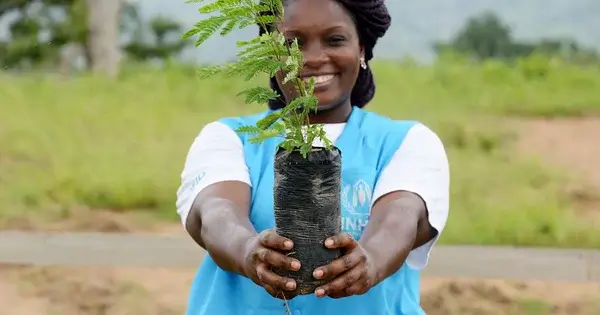
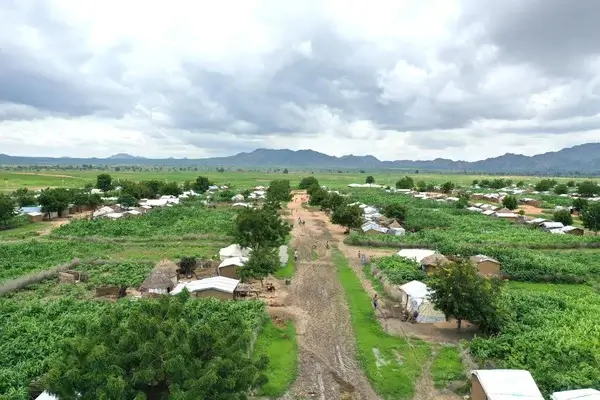
Background and Goal: As global temperatures rise, they’re altering our social and ecological systems, impacting both people and nature. This is causing more and more people to be displaced worldwide. Sadly, up to 86% of these displaced individuals end up in poor countries where resources are already scarce. In 2018, following new violence in nearby countries, thousands of refugees fled to Cameroon. The Minawao refugee camp in Northern Cameroon, originally built in 2013 to accommodate 15,000 refugees, now houses 63,145 Nigerian refugees who sought safety from conflict and violence across the border. The rapid growth of this refugee community has brought about significant environmental and social challenges, such as water shortages, damage to valuable grazing land, desertification, and deforestation.
Main Objectives of the Project:
- Enhance living conditions in the Minawao camp.
- Reduce deforestation in the area by finding alternatives to cutting trees for cooking and preventing soil erosion while improving water infiltration.
- Serve as a model and best practice for other UNHCR refugee sites and the Sahel region.
Actions and Implementation
The Green Refugee Camp tackles two pressing challenges – planetary well-being and refugee conditions – through sustainable methods. It involves three key components:
Sustainable Shelters: Traditionally, UNHCR uses temporary wooden and plastic shelters, which become litter and harm the environment after six months. The Green Refugee Camp introduces sustainable transitional shelters made from locally sourced bricks, eliminating the carbon footprint associated with production and transportation. Results: 14,850 people now have sustainable shelter in Minawao, benefiting a total of 22,445 individuals.
Eco-Friendly Cooking: Gathering firewood causes environmental issues and conflicts. The Green Refugee Camp promotes eco-friendly cooking by using locally produced briquettes from agricultural waste, reducing the need to search for wood outside the camp. In 2017, 4,670 eco-friendly stoves were distributed, and in 2018, local women educated others on eco-friendly stoves and briquettes at community events.
Reforestation and Education: The project addresses deforestation around Gawar and the Zamay Forest Reserve, culturally significant to the Zamay people. Using Land Life’s Cocoon technology, 40,000 trees were planted since 2017, achieving an impressive 85% survival rate. These trees, already over 3 meters tall in 2017, will create mini forests, improving living conditions. The effort also established three tree nurseries and twelve nature clubs to educate children about environmental care.
This multifaceted approach ensures a sustainable and positive impact on both refugees and host communities.
Outcomes and Impacts
Economic Impact:
- Generated 175 local jobs
- Projected production of 2,160 tons of cashews over 20 years
- Projected production of 8,400 tons of neem oil over 40 years
- Projected production of 160,000 tons of fodder over 40 years
- Conserved 2.2 million liters of water (61% less water usage compared to traditional planting)
Social Impact:
- Fostered new connections between host and refugee communities through education, awareness, and action
- Reduced harmful emissions from wood-burning stoves
- Eliminated the need for women and children to embark on dangerous walks in search of firewood
- Enhanced the economic well-being of both refugees and host communities through employment opportunities
- Improved mental health and overall well-being by introducing trees to the refugee camp
Environmental Impact:
- Promoted sustainable sourcing of goods and local production
- Reduced the carbon footprint of UNHCR materials and operations
- Decreased water consumption and enhanced survival rates through the use of Cocoon technology
- Contributed to carbon sequestration through tree planting
Medium-Term Impact:
- The next phase aims to expand reforestation efforts and introduce additional income sources by planting productive trees, including mango, orange, cashew, and moringa trees.
- These trees will offer fresh fruit for families and create opportunities for local sales, addressing irregular access to fresh food in the camp and improving the nutritional quality of residents’ diets.
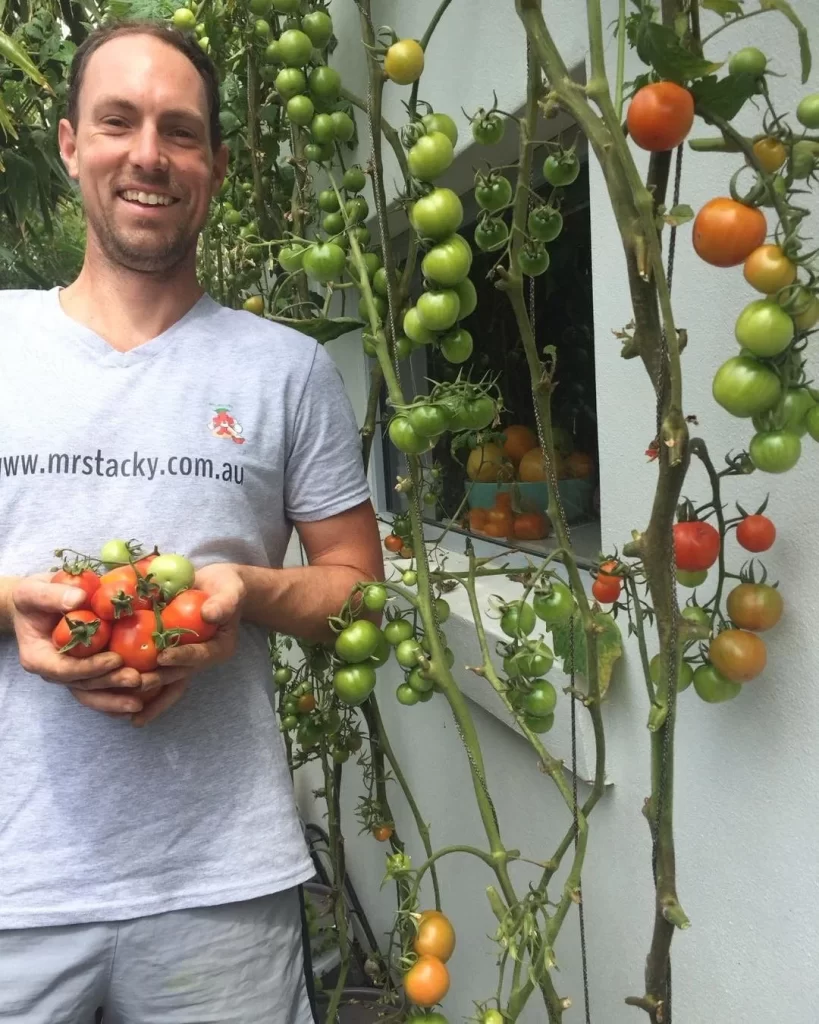
About the Author
Mr Stacky is the leader in Tower Garden Systems in Australia, specializing in commercial hydroponic farming, urban farming & residential vertical gardening.
Find out how he can help you achieve your food production goals. Contact Brian
